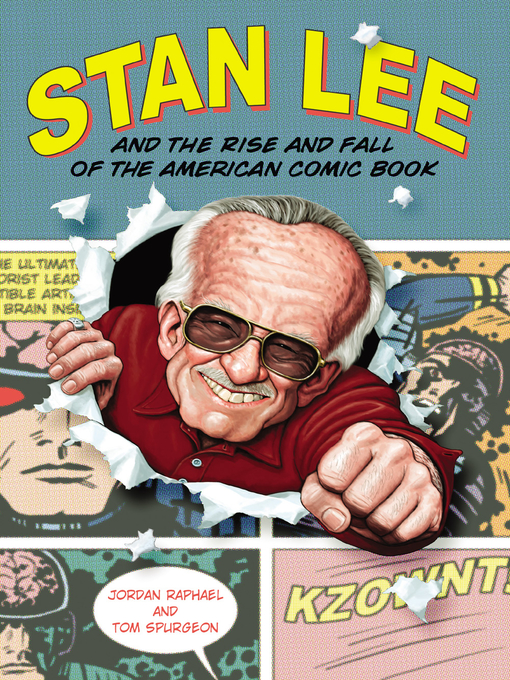-
Creators
-
Publisher
-
Release date
August 17, 2011 -
Formats
-
Kindle Book
-
OverDrive Read
- ISBN: 9781613742921
- File size: 5826 KB
-
EPUB ebook
- ISBN: 9781613742921
- File size: 5826 KB
-
-
Languages
- English
-
Reviews
-
Publisher's Weekly
September 15, 2003
Stan Lee, the cocreator of pop cultural icons like Spider-Man, the Hulk and the X-Men, has long been the subject of debate within the comics community, and Raphael and Spurgeon aim to set the record straight in this well-researched and entertaining book. In the late 1960s, Lee elevated himself into the public eye as the face of Marvel Comics, adopting a colorful persona along the way. Left behind were his c-creators, artists Jack Kirby and Steve Ditko, who never received the credit they deserved. At age 17, in 19TK, Lee (né Stanley Lieber) took a job as an all-purpose assistant at his cousin Martin Goodman's comic book company, Timely. A frustrated novelist, Lee remained at Timely, shielded by Goodman from the industry's mid-century tumults, and eventually he transformed the company into Marvel Comics, steering it and himself into pop culture history. The authors portray Lee as a constantly enthusiastic, slightly daffy figure who turned a Depression-era work ethic and real bursts of creativity into something special. For all of his faults, the authors give Lee proper credit for being a fast and exciting creator—who gave superheroes real-world problems and anxieties and used this realism for its maximum potential. Raphael and Spurgeon also chronicle Lee's decades in the wilderness of Hollywood, trying and failing to get decent films made from Marvel properties. Writer Raphael and cartoonist Spurgeon have put together a solid narrative well interwoven with the history of comics. As they demonstrate well, Lee's story is the story of mainstream comic books and one that is important reading. 12 pages of b&w photos not seen by PW. -
School Library Journal
October 1, 2003
Adult/High School-Raphael and Spurgeon march readers through Lee's first 80 years, taking many compelling byroads along the way to observe the history of American comic-book development, distribution, and readership. Lee created a dynamic and somewhat charismatic persona for himself early in life, and was able to move from technical grunt work to a certain level of co-creativity with more sophisticated artists, and from errand boy to publisher to media mogul. He is, indeed, a part of popular culture with high name recognition. The authors use a variety of resources, including interviews with field specialists and unpublished writings, to substantiate their views of both the man and the medium's evolution. While there are source notes for each chapter, they appear in alphabetical order, making it impossible to find the specific reference to which some controversial declarations are attributed. This will frustrate those doing higher-level research but won't impede casual readers' enjoyment of a colorful man's story told through well-described vignettes.-Francisca Goldsmith, Berkeley Public Library, CACopyright 2003 School Library Journal, LLC Used with permission.
-
Library Journal
November 1, 2003
One of the architects of the modern superhero comic, Lee was head writer and editor at Marvel Comics from 1945 to 1972 and has served as a public frontman for the company ever since. This book, detailing Marvel's history and Lee's work inside and outside of the company, acts as a companion to Lee's 2002 autobiography, Excelsior! (and sports a similar cover). Lee is known largely as the creator of many of Marvel's famous characters, including Spider-Man, the X-Men, and the Hulk. But Raphael and Spurgeon (along with many others) argue that the creative contributions of the artists Lee collaborated with were as important as Lee's own, and the two instead locate Lee's greatest contributions in his dialog writing and his excellent work as editor. The authors expose a few factual inaccuracies that Lee has promulgated about himself over the years and recount the sometimes harsh criticism of Lee as a glory-hog from some artists and industry pundits, but they also show affection for their subject. (Their contention that comics are now a marginal art form, however, is insupportable given the current interest in and success of graphic novels.) Recommended for all libraries.Copyright 2003 Library Journal, LLC Used with permission.
-
Booklist
August 1, 2003
Stan Lee is probably the world's most visible comic-book creator, though he has retired from comics writing. His career in the industry dates from 1940, but he toiled anonymously until vitalizing the field in the early 1960s with Spider-Man, the Fantastic Four, and the other, groundbreaking Marvel Comics superheroes. As Marvel's line grew, Lee turned to overseeing the expanding roster of titles and was gradually eased into being company figurehead, traveling the country to shill for the firm. Recently his reputation has been tarnished by accusations that he tried to hog credit for creating Marvel's iconic characters by minimizing the contributions of the artists who worked with him. This well-researched biography usefully corrects Lee's self-serving memoir " Excelsior!" (2002) and also serves as a critical history of Marvel Comics as well as an overview of the rise and fall of the entire comics industry, now at a commercial nadir, selling a fraction of the number of copies it once did and existing largely, it seems, to develop fodder for blockbuster movies.(Reprinted with permission of Booklist, copyright 2003, American Library Association.)
-
Loading
Why is availability limited?
×Availability can change throughout the month based on the library's budget. You can still place a hold on the title, and your hold will be automatically filled as soon as the title is available again.
The Kindle Book format for this title is not supported on:
×Read-along ebook
×The OverDrive Read format of this ebook has professional narration that plays while you read in your browser. Learn more here.




